A Private Tour to the Norfolk Broads today. We were blessed with a glorious, bright and sunny day and we made the most of it, enjoying the sights, and sounds, that the Broads has to offer.
We started with a drive through the area where the Cranes sometimes like to feed. For such large birds, they can be remarkably difficult to pick up, they seem to blend into the landscape at times. Today, we had no such difficulty – two tall, grey shapes appeared in a marshy field close to the road, actually very close to the road! A pair of Common Cranes. We pulled up quietly and sat in the car watching them. They were clearly aware of our presence, but seemingly unconcerned, walking back and forth, mostly with heads down, looking for food, picking at the ground. The slightly larger male occasionally raised his head to look around, checking on our presence, and the small spot of red on his crown caught the light. We had absolutely stunning views.
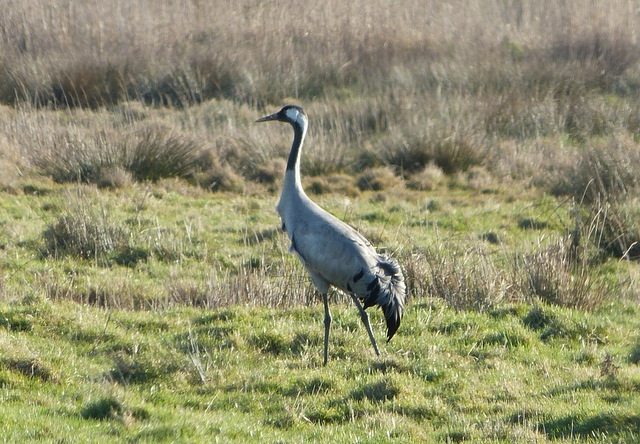

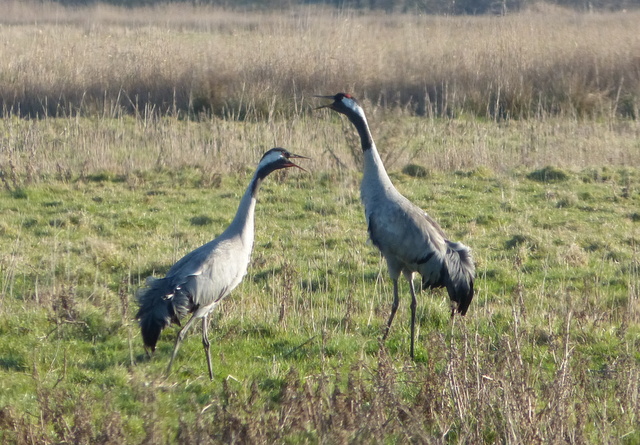 Common Cranes – this pair were feeding next to the road this morning
Common Cranes – this pair were feeding next to the road this morning
Our presence attracted the attention of another car and the Cranes started to work their way further back, clearly now a little more nervous of the increased activity. As they did so, they stopped a few times, heads raised, and broke into bouts of calling, the male starting and the female joining in. The bugling of Cranes is such an amazing sound – the video below shows them feeding and calling.
There were plenty of other things to see on our drive. We pulled up by a short-cropped grassy field which was alive with birds. A huge flock of Golden Plover, some feeding, others sleeping, was interspersed with lots of Lapwing, Fieldfares and Starlings. There are fewer geese along the coast now – a large number of the wintering Pinkfeet appear to have departed already in the last couple of weeks, on their way back north. However, we managed to find a small group of Pink-footed Geese feeding along the edge of a drainage ditch. We stopped to admire them, their pink legs and small pink-banded bills. As the heads were raised occasionally from the long grass, we could see some different birds amongst them, a few of the geese flashing a very bright white blaze around the base of the bill. A small group of White-fronted Geese were mixed in with them and we could even see the distinctive black belly bars of a couple of them.
 White-fronted Geese – a few were mixed in with a small group of Pinkfeet
White-fronted Geese – a few were mixed in with a small group of Pinkfeet
Our next stop was further inland. The herd of wintering wild swans has been rather more mobile in recent weeks, and it is getting to the time when they too may start to depart. We had a quick look at the fields where they have been in recent weeks, but there was no sign, so we headed down to the levels, another favoured area. A tightly packed line of large white shapes quickly revealed itself to be a group of about 35 Bewick’s Swans, the small yellow patch at the base of their bills catching the sun and their distinctive calls carrying to us on the breeze. A little further on, we found another little group of Bewick’s Swans. One in particular was right next to a Mute Swan giving us a great side-by-side comparison, the Bewick’s looking almost goose-like in comparison, much smaller and with a much shorter neck. Whether the flock was just scattered today, or whether some have left, we couldn’t tell. However, we couldn’t find any Whoopers amongst the swans we did manage to locate today.
There is a magical spot just a short drive away and on such a beautiful day, and with the time our own to do with as we pleased today, we decided to divert for a bit of local history. All that remains of St Benet’s Abbey are a few ruins, but it was once one of the richest abbeys in England and was unique in that it was the only abbey not closed down by Henry VIII during the Dissolution of the Monasteries. The view from the high ground, amongst the ruins of the great church, looking to the levels all around, is particularly spectacular.
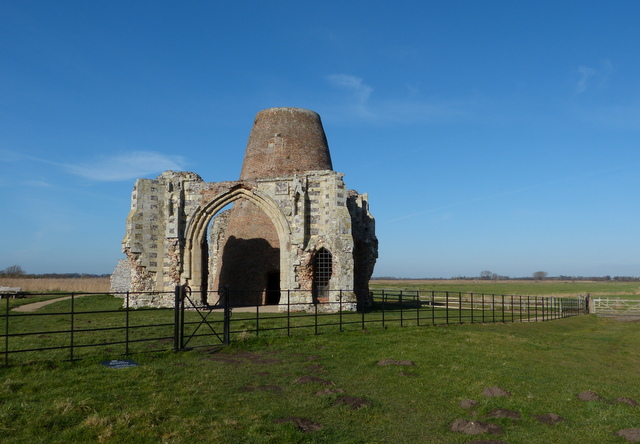 St Benet’s Abbey – the remains of the gatehouse and the levels beyond
St Benet’s Abbey – the remains of the gatehouse and the levels beyond
From there, we headed over to the Yare Valley and a break for lunch. We had not even got out of the car at Strumpshaw Fen when we were greeted by a pair of Marsh Tits calling in the hedge in front of us. We stopped to admire one of them, feeding on something, possibly a seed grabbed from the feeders by the Reception Hide. It looked very smart, in buff and pale brown, with black cap and bright white cheeks. After lunch, we headed out onto the reserve for a quick look at Fen Hide. There were lots of visitors today, presumably with it being half term, and it was rather noisy. Consequently, there was not so much non-human activity on the reserve. A single Marsh Harrier quartered the reedbed, pursued by a crow. We didn’t linger too long.
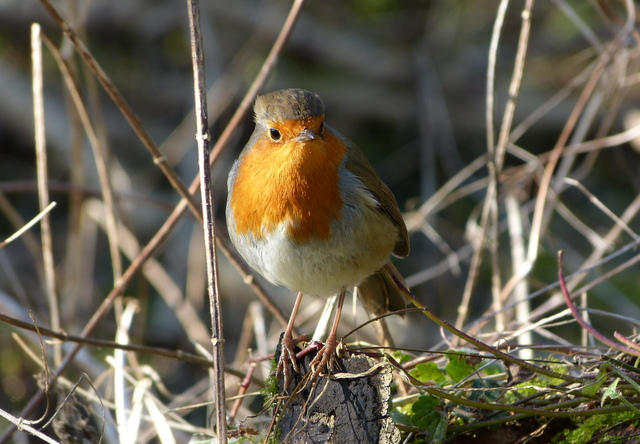 Robin – enjoying the sunshine at Strumpshaw Fen
Robin – enjoying the sunshine at Strumpshaw Fen
It is only a short hop from there to Buckenham Marshes. As usual this winter, there were few geese here, other than several large groups of Canada Geese and a few Greylags. A helicopter flying up the valley even managed to flush those. We saw it coming from some distance, as it put up all the geese from Cantley first – seemingly a nice little flock of Pink-footed Geese still there, though they circled round and appeared to drop down again the other side of the river. As a small group of the Canada Geese flew back later they held a much smaller goose amongst them. A single White-fronted Goose dropped down onto the grass with them, presumably it had been separated from the rest of its kind.
There were still plenty of ducks at Buckenham – still lots of Wigeon feeding on the grass, at least until they were spooked and made for the water in a scramble. Amongst them, we could pick out a pair of Shoveler and several Teal. There were flocks of Golden Plover and Lapwing out on the marshes, but another couple of waders flying in were a couple of Ruff, one a classic winter male and the other a strikingly white-headed bird. Unfortunately, the only Water Pipit we could find flew over our heads calling, and disappeared straight over the river, dropping down over the other side out of view before we could properly get everyone onto it. Otherwise, there were several Meadow Pipits out in the grass. A lone Great Crested Grebe on the river was looking particularly smart in its spring finery.
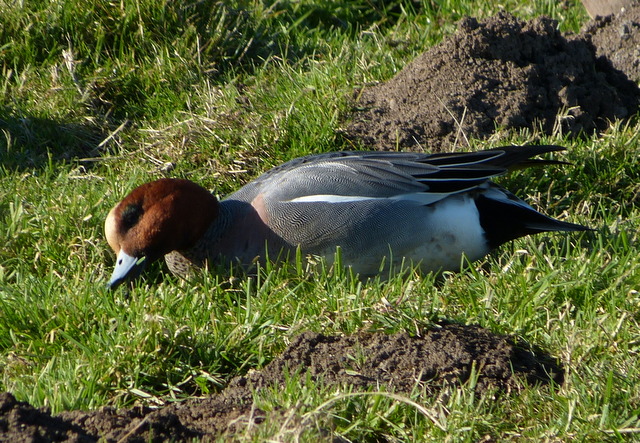 Wigeon – still good numbers at Buckenham today
Wigeon – still good numbers at Buckenham today
Halvergate has been a favourite destination this winter, and we headed over there next for an afternoon coffee break. A quick scan as we got out of the car immediately revealed the resident (for the winter) Rough-legged Buzzard perched on one of its favourite posts. We had a good look at it through the scope, – we could see its blackish belly patch and just about even the feathered legs from which it gets its name – but it wasn’t doing much, only lazily flying from one post to the next. We really wanted to see it fly properly. Thankfully, after a short wait, just enough to whet the appetite, it obliged. It flew straight towards us and proceeded to hover several times, holding its position long enough to allow us to get great views of it through the scope, flashing its white tail base as it went. After showing off for a few minutes, it obviously figured it had given us what we were waiting for and went straight back to its post again!
 Rough-legged Buzzard – on one of its usual posts
Rough-legged Buzzard – on one of its usual posts
A little further along was another small group of 44 Bewick’s Swans. Several of these were really close to the road, so we stopped and got out to admire them. They were totally unconcerned with our presence and we were able to study them closely through the scope.
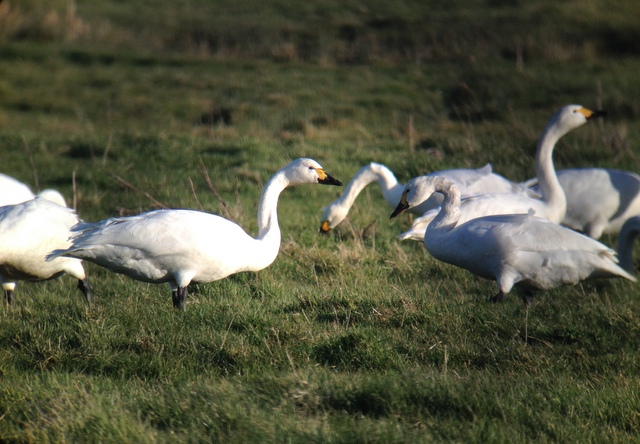
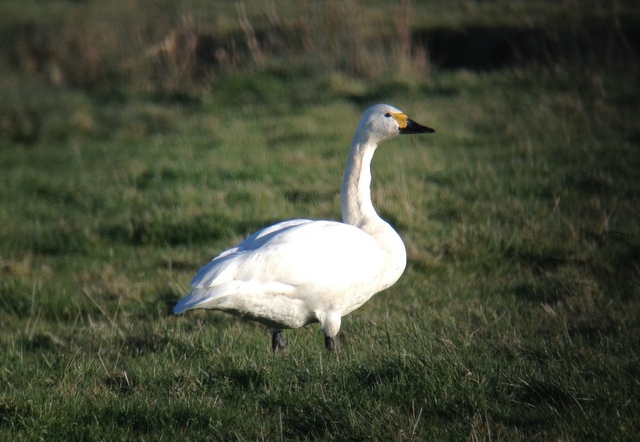 Bewick’s Swans – our second group of the day
Bewick’s Swans – our second group of the day
A couple of Marsh Harriers were quartering the marshes and one smart male came alongside us as we stopped by the road. A pair of Kestrels perched in the hawthorns as we turned round in a gateway. A Chinese Water Deer was trying to hide in a ditch. However, it was possibly still too bright for the Short-eared Owls to come out and we faced a difficult choice – whether to hang on here for them or head back for the harrier roost. In the end, reluctantly, we chose the latter.
The sky was just starting to turn a delicate pink hue as we arrived at Stubb Mill. There were only a couple of Marsh Harriers already out over the reeds, with the others presumably taking advantage of the weather to stay out hunting for as long as possible. They started to drift in, in ones and twos, as we watched. Then a ringtail Hen Harrier appeared low over the marsh in front of us, flashing its white uppertail patch, as it swept past towards the roost. It was followed shortly after by a second ringtail Hen Harrier, this one quite a pale bird, possibly a young (2cy) male. As the light started to fade, the ghostly grey shape of a male Hen Harrier appeared, but unfortunately he was much more distant, trying to slip in through the trees unnoticed. A small shape perched up in one of the trees was surely a Merlin, but it was getting late by that stage.
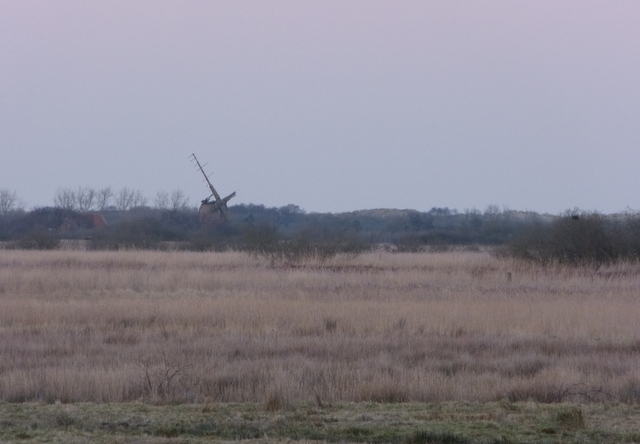 The view from the Stubb Mill watchpoint
The view from the Stubb Mill watchpoint
There were other things to see here as well, as well as the raptors. A pale shape out in the bushes turned out to be a Barn Owl on closer inspection. It sat for some time preening, before eventually setting off for an evening’s hunting. A Tawny Owl hooted from the trees behind us. As the dark descended, the Woodcock started to emerge. Flying fast, they swept out of the trees in ones and twos, swerving low round the bushes before dropping out towards the marshes.
Earlier, a couple of long necks had appeared above the reeds, their black and white faces revealing another pair of Cranes feeding out across the marshes. However, it was almost dark before the other Cranes flew in to roost, some distant bugling alerting us to their setting off – perhaps they were also taking advantage of the lovely bright evening to feed as long as possible. A line of about 20 shapes appeared through the gloom, but most of them appeared to drop down before they got to us, only 5 of them flew on and across past the trees in front. We had been rather spoilt by our views of the Cranes this morning, but as we walked back to the car with the last of the sun’s orange glow on the horizon, we were serenaded by the sound of bugling from across the landscape. An unforgettable end to a glorious day in the Broads.
















